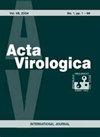基因2型猪瘟病毒E2蛋白保守表位特异性单克隆抗体的鉴定及其鉴别诊断意义
IF 0.8
4区 医学
Q4 VIROLOGY
引用次数: 0
摘要
自上个世纪以来,基因型2经典猪瘟病毒(CSFV)的传播给养猪业造成了重大问题。控制猪瘟的理想策略包括接种疫苗和使农场远离猪瘟。在疫苗接种方面,广泛使用源自基因型1的几种CSFV减毒病毒;对于后者,需要准确诊断以发现CSFV感染。猪瘟病毒的核酸检测通常使用扁桃体样本,这需要一个不方便的采样操作,伤害猪。CSFV抗体或抗原的商业血清学检测无法区分原病毒的基因型。本研究从小鼠杂交瘤细胞中制备了20个单抗。其中4个单克隆抗体仅能识别来自2.1亚基因型菌株的肽,并对其中2个单克隆抗体MM1和MM5进行了进一步研究,以鉴定猪瘟病毒E2蛋白的关键结合位点(表位)。GeneBank共收集到353份2型基因,其中90.9%含有MM1或MM5表位。此外,95.1%的亚基因型2.1分离物含有MM5表位。因此,MM1和MM5具有发展潜力,可作为间接ELISA检测基因型2病毒抗原或竞争性ELISA检测抗体的诊断工具。本文章由计算机程序翻译,如有差异,请以英文原文为准。
Identification of novel monoclonal antibodies specific for the conserved epitopes in the E2 protein of genotype 2 classical swine fever virus: implication for differential diagnosis
Since the last century, the spread of the genotype 2 classical swine fever virus (CSFV) has caused significant issues for the pig breeding industries. Ideal strategies for controlling CSFV include vaccination and keeping farms free of CSFV. For vaccination, several attenuated CSFV viruses originating from genotype 1 are widely used; for the latter, accurate diagnosis is required for detection of the CSFV infection. Nucleic acid testing for CSFV usually uses tonsil samples, which requires an inconvenient sampling operation that injures pigs. Commercial serological tests for CSFV antibodies or antigens are unable to distinguish the genotype for originating virus. In this study, 20 mAbs were developed from the mice hybridoma cells. Four of the mAbs were identified to have the ability to only recognize the peptides derived from sub-genotype 2.1 strain, and two of them, MM1 and MM5, were further studied to identify critical binding sites (epitopes) on the E2 protein of CSFV. A total of 353 genotype 2 collections were made worldwide in GeneBank, 90.9% of which contained MM1 or MM5 epitopes. Moreover, 95.1% of sub-genotype 2.1 isolations contained MM5 epitope. Therefore, MM1 and MM5 have the potential to be developed as a diagnostic tool for detection of genotype 2 virus antigen by indirect ELISA or antibodies by competitive ELISA.
求助全文
通过发布文献求助,成功后即可免费获取论文全文。
去求助
来源期刊

Acta virologica
医学-病毒学
CiteScore
3.10
自引率
11.80%
发文量
43
审稿时长
>12 weeks
期刊介绍:
Acta virologica is an international journal of predominantly molecular and cellular virology. Acta virologica aims to publish papers reporting original results of fundamental and applied research mainly on human, animal and plant viruses at cellular and molecular level. As a matter of tradition, also rickettsiae are included. Areas of interest are virus structure and morphology, molecular biology of virus-cell interactions, molecular genetics of viruses, pathogenesis of viral diseases, viral immunology, vaccines, antiviral drugs and viral diagnostics.
 求助内容:
求助内容: 应助结果提醒方式:
应助结果提醒方式:


